iPad 4 GPU Performance Analyzed: PowerVR SGX 554MP4 Under the Hood
by Anand Lal Shimpi on November 2, 2012 1:46 PM ESTAs always, our good friends over at Kishonti managed to have the first GPU performance results for the new 4th generation iPad. Although the new iPad retains its 2048 x 1536 "retina" display, Apple claims a 2x improvement in GPU performance through the A6X SoC. The previous generation chip, the A5X, had two ARM Cortex A9 cores running at 1GHz paired with four PowerVR SGX 543 cores running at 250MHz. The entire SoC integrated 4 x 32-bit LPDDR2 memory controllers, giving the A5X the widest memory interface on a shipping mobile SoC in the market at the time of launch.
The A6X retains the 128-bit wide memory interface of the A5X (and it keeps the memory controller interface adjacent to the GPU cores and not the CPU cores as is the case in the A5/A6). It also integrates two of Apple's new Swift cores running at up to 1.4GHz (a slight increase from the 1.3GHz cores in the iPhone 5's A6). The big news today is what happens on the GPU side. A quick look at the GLBenchmark results for the new iPad 4 tells us all we need to know. The A6X moves to a newer GPU core: the PowerVR SGX 554.
| Mobile SoC GPU Comparison | |||||||||||
| PowerVR SGX 543 | PowerVR SGX 543MP2 | PowerVR SGX 543MP3 | PowerVR SGX 543MP4 | PowerVR SGX 554 | PowerVR SGX 554MP2 | PowerVR SGX 554MP4 | |||||
| Used In | - | iPad 2 | iPhone 5 | iPad 3 | - | - | iPad 4 | ||||
| SIMD Name | USSE2 | USSE2 | USSE2 | USSE2 | USSE2 | USSE2 | USSE2 | ||||
| # of SIMDs | 4 | 8 | 12 | 16 | 8 | 16 | 32 | ||||
| MADs per SIMD | 4 | 4 | 4 | 4 | 4 | 4 | 4 | ||||
| Total MADs | 16 | 32 | 48 | 64 | 32 | 64 | 128 | ||||
| GFLOPS @ 300MHz | 9.6 GFLOPS | 19.2 GFLOPS | 28.8 GFLOPS | 38.4 GFLOPS | 19.2 GFLOPS | 38.4 GFLOPS | 76.8 GFLOPS | ||||
As always, Imagination doesn't provide a ton of public information about the 554 but based on what I've seen internally it looks like the main difference between it and the 543 is a doubling of the ALU count per core (8 Vec4 ALUs per core vs. 4 Vec4). Chipworks' analysis of the GPU cores helps support this: "Each GPU core is sub-divided into 9 sub-cores (2 sets of 4 identical sub-cores plus a central core)."
I believe what we're looking at is the 8 Vec4 SIMDs (each one capable of executing 8+1 FLOPS). The 9th "core" is just the rest of the GPU including tiler front end and render backends. Based on the die shot and Apple's performance claims it looks like there are four PowerVR SGX554 cores on-die, resulting in peak theoretical performance greater than 77 GFLOPS.
There's no increase in TMU or ROP count per core, the main change between the 554 and 543 is the addition of more ALUs. There are some more low level tweaks which helps explain the different core layout from previous designs, but nothing major.
With that out of the way, let's get to the early performance results. We'll start with low level fill rate and triangle throughput numbers:
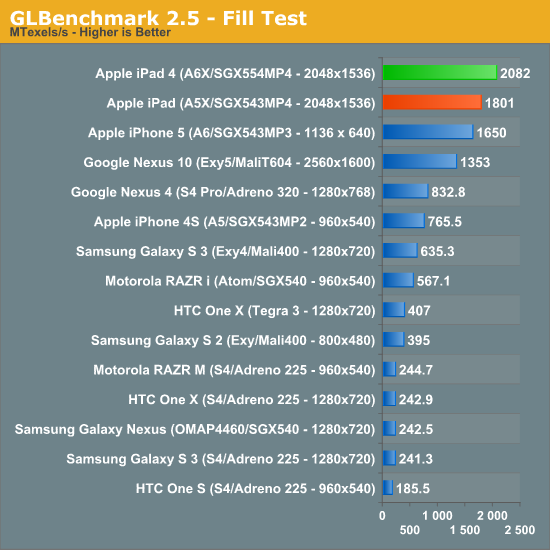
Fill rate goes up by around 15% compared to the iPad, which isn't enough to indicate a huge increase in the number of texture units on the 554MP4 vs. the 543MP4. What we may be seeing here instead are benefits from higher clocked GPU cores rather than more texture units. If this is indeed the case it would indicate that the 554MP4 changes the texture to ALU ratio from what it was in the PowerVR SGX 543 (Update: this is confirmed). The data here points to a GPU clock at least 15% higher than the ~250MHz in the 3rd generation iPad.
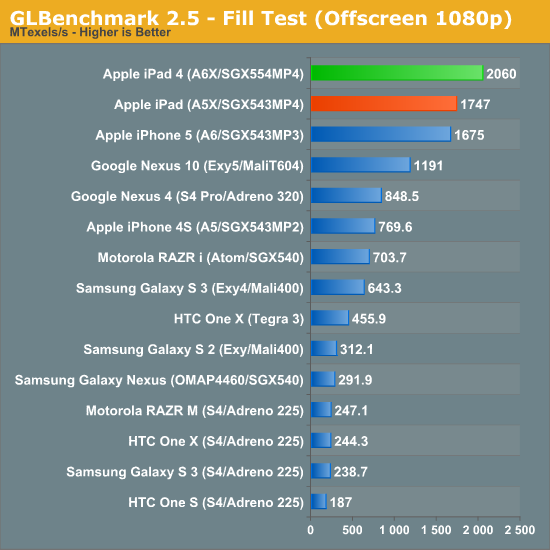
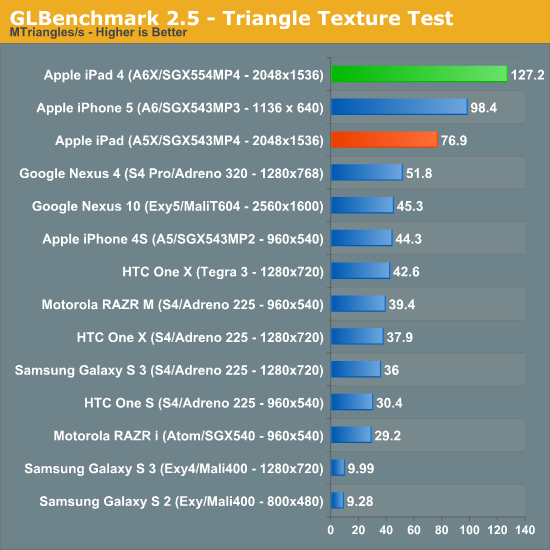
Triangle throughput goes up by a hefty 65%, these are huge gains over the previous generation iPad.
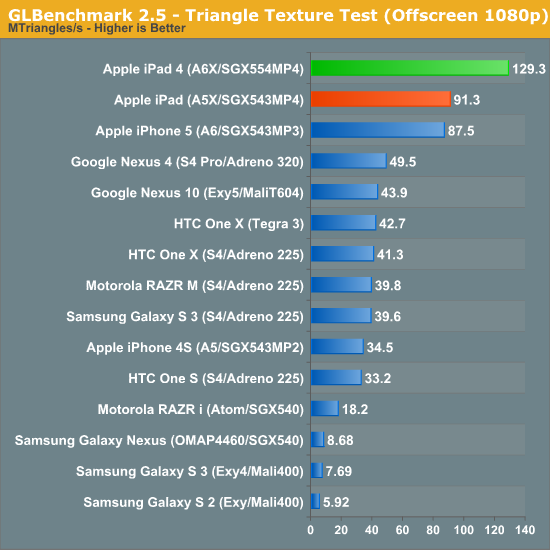
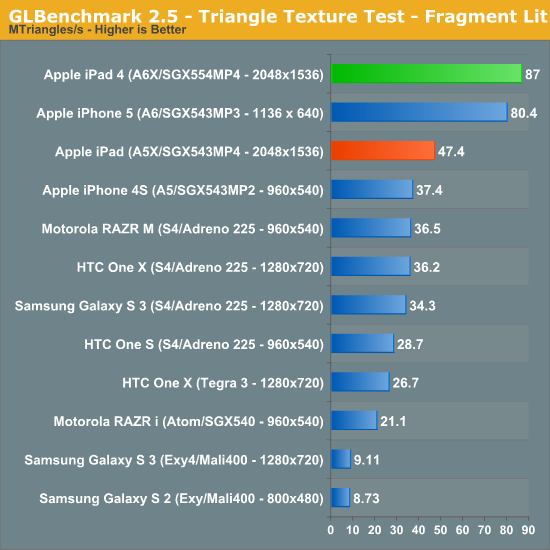
The fragment lit triangle test starts showing us close to a doubling of performance at the iPad's native resolution.


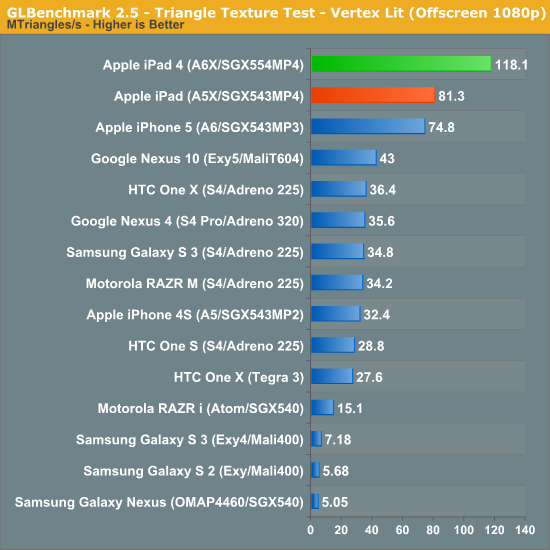

Throw in a more ALU heavy workload and we really start to see the advantage of the new GPU: almost double the performance in Egypt HD at 2048 x 1536. We also get performance that's well above 30 fps here on the iPad at native resolution for the first time.
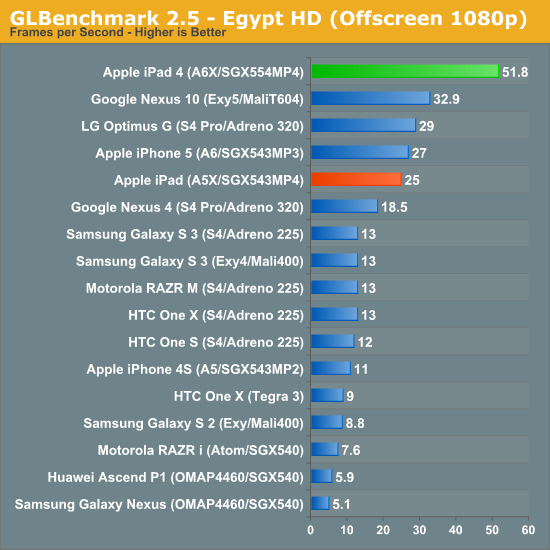
Normalize to the same resolution and we see that the new PowerVR graphics setup is 57% faster than even ARM's Mali-T604 in the Nexus 10. Once again we're seeing just about 2x the performance of the previous generation iPad.
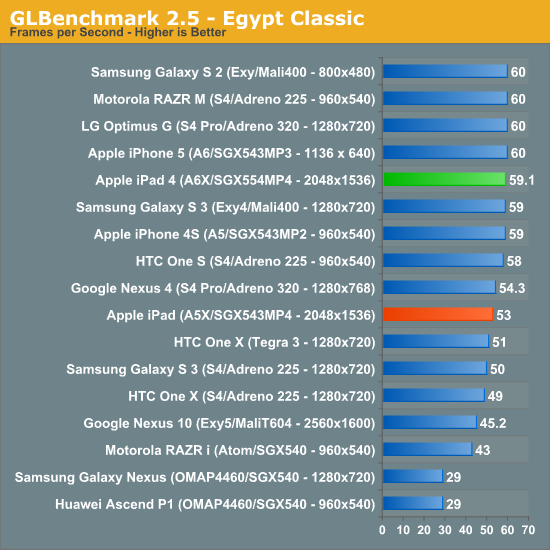
Vsync bound gaming performance obviously won't improve, but the offscreen classic test gives us an idea of how well the new SoC can handle lighter workloads:
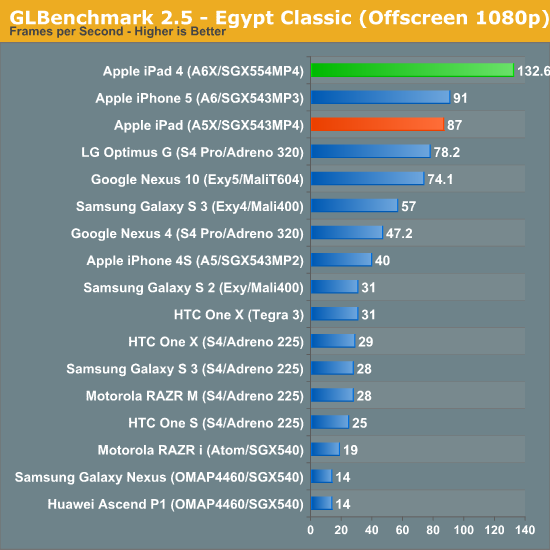
For less compute bound workloads the new iPad still boasts a 53% performance boost over the previous generation.
Ultimately it looks like the A6X is the SoC that the iPad needed to really deliver good gaming performance at its native resolution. I would not be surprised to see more game developers default to 2048 x 1536 on the new iPad rather than picking a lower resolution and enabling anti-aliasing. The bar has been set for this generation and we've seen what ARM's latest GPU can do, now the question is whether or not NVIDIA will finally be able to challenge Imagination Technologies when it releases Wayne/Tegra 4 next year.



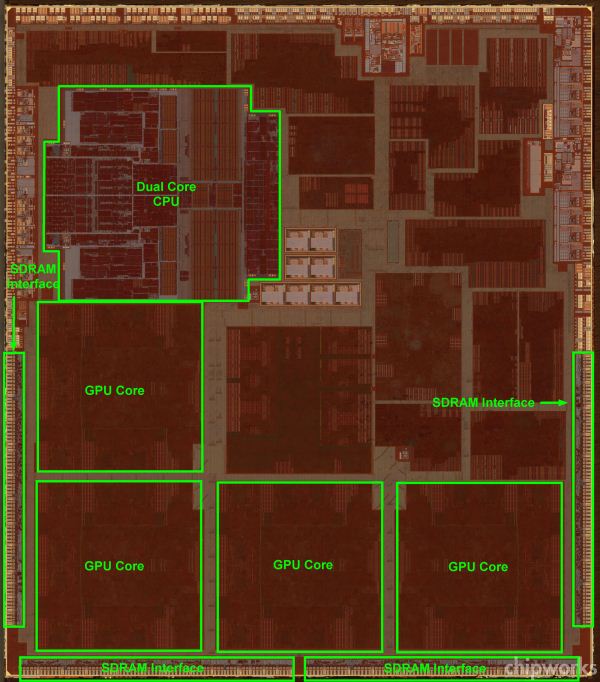








113 Comments
View All Comments
krazyfrog - Friday, November 2, 2012 - link
Not quite the 2x performance over the A5X that Apple promises but impressive nonetheless. Curious to know what’s the situation with the heating is like with the A6X.ltcommanderdata - Friday, November 2, 2012 - link
Well compared to the A5X they've moved from a 45nm process to a 32nm process and the clock speed increase is very modest over the A6 in the iPhone 5 despite the much larger tablet form factor, so presumably things are under control.Alexvrb - Saturday, November 3, 2012 - link
Well in terms of raw compute performance it really IS a 2x increase. So for compute-bound situations... well just look at the Egypt HD results above. But as always, real world performance in a lot of situations isn't going to net the same results. Doubling the compute performance won't normally equate to twice the frames, especially since memory bandwidth and fill rate didn't double too.Still, I'm glad to see the 554 being used in an actual chip design. I think even a 2 or 3 core variant would be great in a phone. It performs very well and makes me look forward to Series 6 even more. PowerVR has consistently put out good mobile designs, that's for certain. I would like to see more cutting-edge PowerVR designs outside of Apple devices, of course.
VeronRio - Sunday, November 4, 2012 - link
Love my job, since I've been bringing in $5600… I sit at home, music playing while I work in front of my new iMac that I got now that I'm making it online(Click on menu Home)http://goo.gl/wec69
Achtung_BG - Friday, November 2, 2012 - link
Do you know how big this chip die size mm2 ?ltcommanderdata - Friday, November 2, 2012 - link
http://www.chipworks.com/blog/recentteardowns/2012...The A6X is 123 mm2. 30% larger than the A6.
ltcommanderdata - Friday, November 2, 2012 - link
When the iPad 3 increased the pixel count by 4x with only a 2x increase in GPU power the concern was whether it'd be fill rate limited. Now with the iPad 4, the ALU performance has theoretically increased more than 2x due to doubled ALU count and higher clock speed putting it above the iPad 2 on a per pixel basis. However, the fill rate has only increase modestly with clock speed since the ROP count remains the same, putting it still below the iPad 2 on a per pixel basis. The Egypt HD results suggests that the relative fill rate deficit doesn't limit performance at native Retina resolution compared to the iPad 2 at native resolution. Do we expect this to be the case in real world high-end games as well?Kevin G - Friday, November 2, 2012 - link
The issue I think we're running into isn't fill rate directly but rather memory bandwidth. It is evident that the iPad 4 keeps the 128 bit wide memory interface but the clock speed of that bus is still known to my knowledge. The A6 brought some much needed efficiency improvements in the memory controller that should translate well to the A6X. I'm really curious what bandwidth figures the A6X can produce.I'm also kinda surprised that Apple is only going with a 1.4 Ghz core clock in the iPad 4. I would have suspected something a bit higher, at least for a turbo mode. Then again they doubled GPU performance and it looks like most of the power headroom with the tablet form factor went there.
ltcommanderdata - Friday, November 2, 2012 - link
Apple went from LPDDR2-800 to LPDDR2-1066 for the A5 vs the A6 so I expect the same bump occurred between the A5X and A6X.DERSS - Friday, November 2, 2012 - link
Since Egypt test, even in HD version, is old and does not really uses advanced sharers and other fancy technologies, it is not indication of real high-end games you speak about of.There is no real game-like test, unfortunately. Maybe some could do such test based on a scene from upcoming Infinity Blade 3 game or something, but Egypt test does not tell us much.